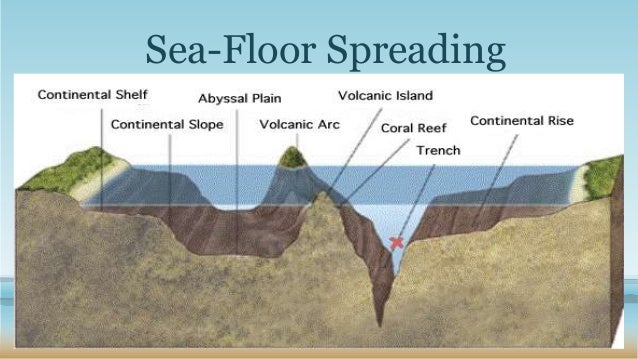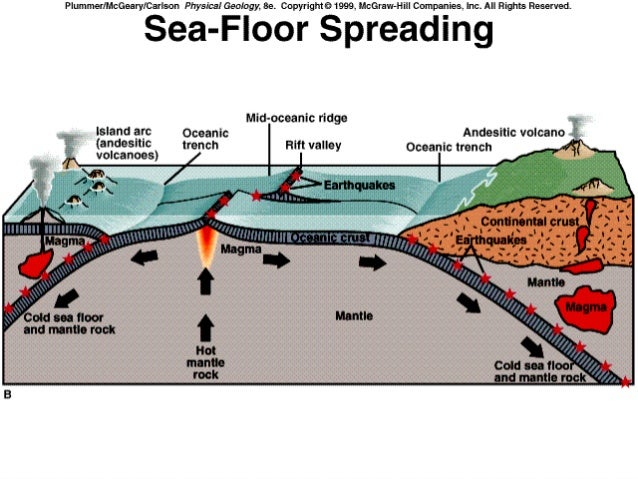Seafloor Spreading Diagram

Sea Floor Spreading
Seismic activity (see Chapter 7 of Stein and Klosko) directly below the ocean ridge axis is limited to shallow (d < 10 km) low magnitude (M < 6) earthquakes, apparently caused by the tensile stress associated with the expansion of the seabed. As demonstrated by Raff and Mason (1961), for example, there are striking zebra patterns of geomagnetic anomalies, with widths of 20 to 30 km and lengths of several hundred km in the northeast Pacific to the off the coast of North America. The pattern of geomagnetic intensity anomalies on either side of the rise was then shown to fit perfectly with the pattern based on the history of the geomagnetic reversal that had been obtained from the paleomagnetic studies of the Earth's rocks. (Pitman and Heirtzler, 1966). They analyzed the long and numerous geomagnetic profiles for each of the world's oceans, and by 1968 had demonstrated that magnetic band patterns in different oceans are correlated down to about 80 Ma of seafloor (Heirtzler et al., 1968) . As the current Pacific plate grew, the spreading ridge (East Pacific Ridge, EPR) migrated eastward, and the seabed produced on the east side of the ridge was continuously subducted beneath North America. Considering the width of the MQZ and its age range, the rate of seafloor spreading appears to have been 50–75% faster during the Cretaceous period (124–83 Ma) than during other periods.In the 1950s and 1960s, ocean research suggested that the seabed was moving away from the mid-ocean ridges, taking the continents with them. • The spreading seafloor hypothesis proposed that magma rises to the surface at mid-ocean ridges, creating new seafloor. As seafloor rocks move away from the mid-ocean ridge, they become colder and denser, eventually sinking or supporting inside the earth. Magma from inside the Earth rises along the mid-ocean ridge and then cools to form new rocks under the sea. Magnetic signatures in seabed rocks indicated that the rocks formed at the mid-ocean ridge and moved apart as new seabed was created.
Recognizing Detachment-Mode Seafloor Spreading In The Deep Geological Past
However, the acquisition of remanence during or shortly after formation by seabed propagation in upper crustal sites is supported by: (i) the presence of normal (10 sites) and reversed (4 sites) remanence polarities ), consistent with rapid polarity changes in the Jurassic21 and inconsistent with pervasive later remagnetization; and (ii) mean inclinations of the upper crustal sites (in situ coordinates and corrected for inclination) consistent with those expected from the European paleomagnetic pole of the Jurassic (170 Ma)22, assuming that the ophiolite is associated with the dominant European plate of the Tethys realm during intraoceanic subduction. A unique net tectonic solution for the footwall rotation (axis = 029°/11°, amplitude = 46° counterclockwise) is then provided by the intersection of the mean dyke orientation and the bisector of the large circle of the mean footwall and hangingwall remanence directions (white star in Fig. Full size imageThe confidence limits (α 95 values) on the two directions of remanence and the mean orientation of the dyke lead to uncertainties in these rotational parameters, generating a wasp-waisted envelope of potential great circle bisectors and a narrow envelope d allowable dam orientations (shaded regions in Fig.
# Video | Seafloor Spreading Diagram
- Mittelozeanischer Rücken Seafloor Spreading
- Seafloor Spreading Für Kinder Erklärt
- Seafloor Spreading Hypothese Deutsch
- Seafloor Spreading Folgen
- Sea-Floor Spreading Beispiel
Seafloor Spreading Diagram Answer Key
After Studying The Continental Drift Theory You Have An Idea Of What Earth Looked Like200- 300 Million Years Ago. Hypothesize About What Earth Will Look.
4 Underwater drilling5 Resolution
6
7 Ages of the Seabed Activity
Choose seven different colors. Follow the instructions on the activity sheet to color the Ages of the Seabed worksheet and answer the questions. 8 Agenda for the day Finish coloring the seabed map (when work on the geological puzzle deck is complete) Discuss/label the seabed map Answer the seabed questions on the worksheet
9 Map of Seabed Ages Look at your map. Use a world map and label the oceans (Pacific, Atlantic) Label each land area (grey areas) with continent names Look at the colors on the maps. (pg 40 has photos) Answer the lab questions on your worksheet (use figures 19, 21 and 23 in your book) When you're done, you can continue working on your geological puzzle deck
11 Seafloor spreading diagram
12
13
14
15
16 Read pages 33 to 39 Pay particular attention to: Diagrams Words in bold
Bold statements Section titles Check your understanding: can you answer the checkpoint and review questions? 17 Bill Nye Seabed Spreading Video
Subduction Zone - Pacific Rim Video:
18 seabed spreading animations
19 Evidence of Magnetic Field Changes in the Seabed
20
21
22
23 Seabed Spreading Pattern - 1
What feature of the ocean floor does the central cleft represent? 24 Seafloor Spreading Model-2
What are the side slits? 25 Seafloor Spreading Model-3
How does the ocean floor, represented by the part of a strip near the center slit, differ from the ocean floor, represented by the part near a side slit? The ocean floor near the central cleft is younger, warmer, and less dense than the ocean floor farther away. The ocean floor near the lateral clefts is older, cooler, and denser. 27 Seafloor Spreading Model-4
What do the stripes on the bands mean? 28 Seabed Spreading Model-5
Explain how differences in density and temperature provide some of the force needed to cause propagation and subduction of the seafloor. 29 Seabed Spreading Pattern-6
Use your own words to describe the process of seabed spreading. The response should include: eruption of molten material at the mid-ocean ridge extending seabed subduction of oceanic crust into deep ocean trenches.
Seafloor Spreading Diagram With Label
Theory And Evidence Of Seafloor Spreading
Seafloor spreading is a geological process in which new oceanic crust is gradually added to the ocean floor through volcanic activity while pushing older rocks away from the mid-ocean ridge. Seafloor spreading causes the ocean floor to renew every 200 million years, a time period for the construction of a mid-ocean ridge, receding across the ocean and subduction into a trench. This causes the temperature near the mid-ocean ridge to become warm and the other surface to become cold because as molten magma continues to push upward, it pushes rocks away from the ridge.Ocean Floor Spreading Diagram
Ocean Floor Diagram
This is a worksheet designed to help students understand the different parts of the ocean floor. Older students should be able to complete it independently. It can be printed in color or black and white. There is an easel activity included. It includes a labeling worksheet with a detailed version of the pa# Images | Seafloor Spreading Diagram - Label Subduction Diagram
Seafloor Spreading Island - Earth'S Continental Plates
 Save
Save
Sea Floor Spreading - Label Of Divergent Boundary
 Save
Save